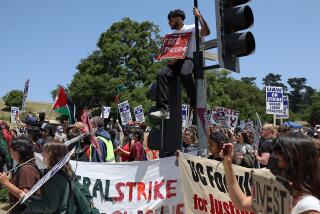Lessons From the Battleground to the Playground : Education: Stress-relief techniques developed by a psychologist for the children of soldiers in wartime are being used at Ritter Elementary School in Watts.
One child dreams of moving out of the area because the frequent gunfire means no chance to play. Another’s only wish is that her parents would stop taking drugs. Others don’t like to walk to school because they fear crime.
These are stories commonly told by students at Ritter Elementary School in Watts. Noted psychologist Dennis Embry hears such fear and apprehension a lot too--but from the children of soldiers coping with war.
Now, the stress relief techniques Embry developed for the children of soldiers in wartime are being applied at Ritter, the first Los Angeles Unified School District to adopt his PeaceBuilders program.
Under the auspices of state Sen. Teresa Hughes (D-Inglewood), who is chairwoman of the Senate Subcommittee on School Safety and an advocate of Embry’s program, PeaceBuilders is being tested at Ritter with a $2,000 grant from Pacific Bell. Hughes is also working on introducing the program, which costs $3.52 per student, at 102nd Street Elementary School.
Soldiers’ children get anxious imagining themselves on the battlefield with their parents--or envisioning their deaths. For kids in Watts, the violence is often closer to home.
“We were standing outside of our apartment with my cousin and his sister and gangbangers drove by and shot my cousin in the head,” Yvette Morgan, 9, told her fourth-grade class during a PeaceBuilders session mediated by Earline Henderson, the school counselor.
When Henderson asked the class of 30 students how many have seen or known someone in their family who has been killed or wounded by gunfire, 14 children raised their hands.
“There was just a shooting last night. There’s shooting every night,” said Janice Bright, 10, a fifth-grader at Ritter. “We try to ignore it, but we can’t. It hurts inside.”
“We don’t even get a chance to play because of the shootings,” said Audrey Taylor, 10, Janice’s classmate and a neighbor at the Imperial Courts housing project.
With that type of violence--there have been seven murders this year in the neighborhood around the school--Ritter seemed an ideal proving ground for the program, which has been embraced by schools in Texas, Arizona and California.
Embry is an Arizona psychologist who received national recognition for his efforts in helping military children and their families distressed by the Persian Gulf War.
His program is based on approximately 150 federally and privately funded studies on violence prevention that examined behavioral patterns of wartime children and their parents from the Vietnam War through the Gulf War.
“People’s chemistry changes during wartime situations,” Embry said, offering his finding that children around the threat of violence become belligerent and overly vigilant and often have difficulty relating with people. “So we began to systematically explore how violence affects people in the inner city.
“There are 200 acts of aggression on an average day at elementary school playgrounds,” said Embry, president of Heartsprings, a Tuscon company that has designed books for parents, teachers and students to help children cope with war. “Kids don’t grow up and out of it, they grow meaner and nastier.”
PeaceBuilders teaches children and their parents methods to reduce aggression, increase positive relationships and improve academic success. The program starts by encouraging students to follow four principles: praise people for doing something nice, discontinue put-downs because it makes people sad and angry, notice and speak up about a hurt you’ve caused someone else, and find adults to help you.
At Ritter, teachers spend a few minutes out of the regular instruction period and explain PeaceBuilder concepts to students. “Teachers are enthusiastic about the program and they see it as something they can use (within their lectures),” said Ritter Principal Mary Stallings.
The violence-prevention program, targeting kindergarten through fifth-grade students, was first used at a housing project in San Bernardino in August, 1993. The program eventually spread to 29 schools, after-school programs and preschool programs in high-crime urban areas in San Bernardino and Riverside counties.
Studies of 13 schools in San Bernardino County using PeaceBuilders showed major drops in vandalism, violence on playgrounds and discipline problems among students.
“Two or three years ago, students walked in a more defensive manner, as if threatened,” said Principal Judy White of San Bernardino’s Emmerton Elementary School, which started to use the program in March. “Now we’ve restored hope to the kids. There’s an air of peace among the students and they are more productive.”
White said that since PeaceBuilders was implemented at Emmerton there has been a 62% reduction in suspensions as well as a significant drop in the number of children sent to her office for fighting. “Peace has become contagious in our school,” she said.
Part of the program requires teacher and parent participation, an important factor in the spreading of peace in the community, Embry said.
“This will teach the social and emotional skills that we need in this area,” said Henderson.
Building on one of the main concepts of the program, teachers are encouraged to send positive notes to parents about their child’s behavior rather than the more common note describing a child’s misbehavior at school. By promoting a child’s good deeds over the bad, children are more inclined to behave better for the recognition, Stallings said.
“You don’t know how difficult it seems for kids to say something nice to each other, but with PeaceBuilders they’ve actually learned to give praises and make friends,” said Henderson.
In addition, a PeaceBuilders workbook with the basic principles of the program given to students encourages parents to work with their children at home.
“Parents have reported that (PeaceBuilders) has become part of their vocabulary at home,” said White. “It makes them think twice about how to solve problems.”
The outcome of the program at Ritter will not be determined for at least three months, Stallings said, although school officials report fighting on the playground already has decreased significantly.
“I can see positive difference in attitudes in the children and the teachers,” said Stallings. “It doesn’t mean there won’t be any more fights again, but children have become aware of how to avoid them through PeaceBuilders.”
More to Read
Start your day right
Sign up for Essential California for news, features and recommendations from the L.A. Times and beyond in your inbox six days a week.
You may occasionally receive promotional content from the Los Angeles Times.






